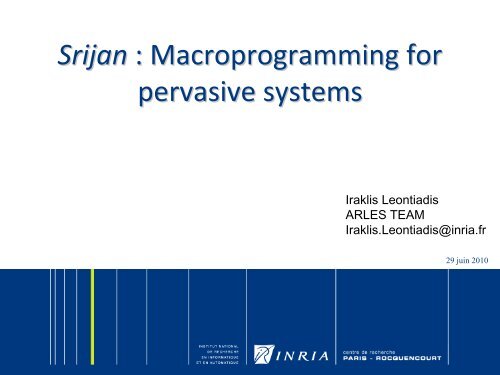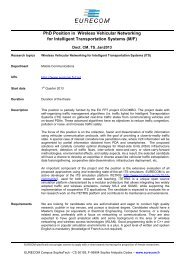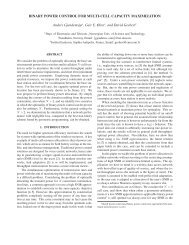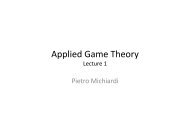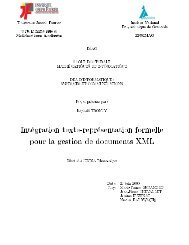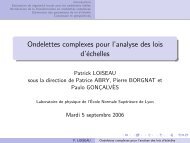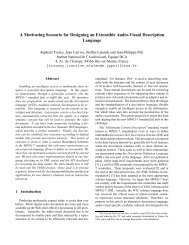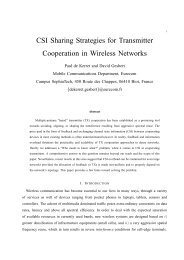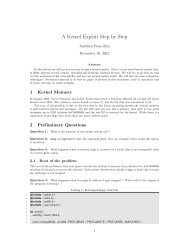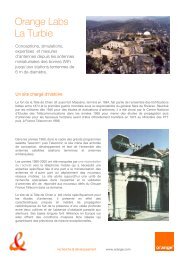Srijan: Macroprogramming for the IoT - Eurecom
Srijan: Macroprogramming for the IoT - Eurecom
Srijan: Macroprogramming for the IoT - Eurecom
Create successful ePaper yourself
Turn your PDF publications into a flip-book with our unique Google optimized e-Paper software.
<strong>Srijan</strong><br />
: <strong>Macroprogramming</strong><br />
pervasive<br />
systems<br />
<strong>for</strong><br />
Iraklis Leontiadis<br />
ARLES TEAM<br />
Iraklis.Leontiadis@inria.fr<br />
1<br />
29 juin 2010
Overview<br />
•<br />
•<br />
•<br />
•<br />
Pervasive systems<br />
<strong>Macroprogramming</strong><br />
<strong>Srijan</strong><br />
toolkit<br />
Future work<br />
2
Pervasive Systems(1)<br />
•<br />
•<br />
•<br />
A class of mobile devices cooperate toge<strong>the</strong>r.<br />
Aware of location , identity and resources.<br />
The end user does not know about <strong>the</strong> diversity of<br />
devices in resource characteristics (cpu , memory,<br />
connectivity).<br />
3
Wireless sensor networks applications<br />
•<br />
•<br />
•<br />
•<br />
•<br />
Rapidly emerged as a new type of distributed<br />
pervasive systems in different domains.<br />
Building management systems.<br />
Traffic management.<br />
User tracking.<br />
Health monitoring.<br />
4
<strong>Macroprogramming</strong><br />
•<br />
•<br />
•<br />
•<br />
(1)<br />
“Reason at <strong>the</strong> level of <strong>the</strong> system, not <strong>the</strong> nodes”<br />
The promise: make development of complex sensor<br />
network applications easy<br />
Inputs:<br />
• High‐level application description. E.g. Task Graph<br />
• In<strong>for</strong>mation about target network. E.g. Topology<br />
[Tree]<br />
Output:<br />
• Customized node‐level code <strong>for</strong> each node in <strong>the</strong><br />
5<br />
system
<strong>Macroprogramming</strong><br />
•<br />
(2)<br />
Why “macro”?<br />
• More and more sensing applications become more<br />
mature.<br />
• Complexity is increased with all <strong>the</strong>se different<br />
type of nodes.<br />
• Nodes are heterogeneous.<br />
• Easy programming<br />
• More effective and less timeless development.<br />
6
<strong>Srijan</strong><br />
•<br />
•<br />
•<br />
•<br />
toolkit<br />
Enables easy programming of wireless sensor nodes<br />
You define <strong>the</strong> behavior of <strong>the</strong> system without<br />
thinking <strong>the</strong> specifications of each node.<br />
<strong>Srijan</strong> is responsible to create code templates <strong>for</strong><br />
different types of nodes<br />
Based on <strong>the</strong> ATaG<br />
macroprogramming<br />
language.<br />
7
<strong>Srijan</strong><br />
•<br />
•<br />
•<br />
•<br />
components<br />
Network description module(NDM)<br />
Task Graph User Interface module(TGUIM)<br />
Auto Code Generator(ACG)<br />
Compilation –<br />
Deployment module(CDM)<br />
8
<strong>Srijan</strong><br />
flow process<br />
TGUIM ACG<br />
NDM<br />
ATaG<br />
CDM<br />
Generated<br />
Templates<br />
9
Network description module<br />
•<br />
•<br />
•<br />
Responsible <strong>for</strong> <strong>the</strong> definition of <strong>the</strong> network<br />
topology<br />
Addressing details and capabilities <strong>for</strong> each node<br />
Example in a simple text file<br />
0014.4F01.0000.0642 room:0 attachedSensors:TemperatureSensor freespot<br />
0014.4F01.0000.02E0 room:0 attachedActuators:TemperatureActuator freespot<br />
10
•<br />
Task Graph User Interface module(1)<br />
ATaG<br />
: Abstract Task Graph<br />
• Tasks interact with each o<strong>the</strong>r by<br />
producing/consuming Data Items<br />
• Annotations define <strong>the</strong> rules <strong>for</strong> placement, firing<br />
and interest<br />
Task<br />
DataItem<br />
[nodes-per-instance:<br />
1@TemperatureSensor]<br />
[periodic:10]<br />
Sampler<br />
local<br />
Temperature<br />
[region-per-<br />
instance:1/Floor]<br />
1 hop:<br />
Floor<br />
[any-data]<br />
Cluster-<br />
Head<br />
Channel<br />
11
•<br />
Task Graph User Interface module(2)<br />
Firing Rules<br />
• periodic: –fires periodically<br />
• anydata –fires when any incoming data item<br />
arrives<br />
• alldata –fires only when all incoming data<br />
items arrive<br />
12
•<br />
Task Graph User Interface module(3)<br />
Instantiation Rules<br />
• nodes-per-instance:[@NodeType]<br />
–<br />
one copy of <strong>the</strong> task <strong>for</strong> every nodes [of<br />
type NodeType]<br />
– “One sampling task on each node with a<br />
temperature sensor”<br />
• region-perinstance:/RegionLabel<br />
– copies of <strong>the</strong> task in each set of nodes<br />
with <strong>the</strong> same RegionLabel<br />
– “One collecting task per Floor”<br />
13
•<br />
•<br />
•<br />
Auto code Generator<br />
For each different type of nodes <strong>Srijan</strong> will produce<br />
code templates depending on <strong>the</strong> task graph.<br />
The developer writes <strong>the</strong> bussiness model of <strong>the</strong><br />
application on <strong>the</strong>se templates.<br />
Finally <strong>for</strong> each node of <strong>the</strong> WSN <strong>Srijan</strong> will produce<br />
and deploy code segments.<br />
14
•<br />
•<br />
•<br />
•<br />
Compilation –Deployment module<br />
The developer opens <strong>the</strong> imperative code templates<br />
and fills <strong>the</strong>m in with specific code details.<br />
<strong>Srijan</strong><br />
creates <strong>the</strong> final code <strong>for</strong> each node.<br />
Compiles <strong>the</strong> code.<br />
Deploy on nodes.<br />
15
•<br />
•<br />
•<br />
•<br />
Implementation<br />
<strong>Srijan</strong><br />
is implemented in Java.<br />
A plugin <strong>for</strong> Eclipse was created to allow <strong>the</strong> user<br />
specify <strong>the</strong> ATaG and <strong>the</strong>n to load <strong>the</strong> <strong>Srijan</strong> toolkit.<br />
The ATaG was created with <strong>the</strong> EMF plugin of Eclipse,<br />
which lets you define metamodels.<br />
The metamodel<br />
was created with GEMS<br />
16
•<br />
Testing nodes(1)<br />
Sun SPOTs<br />
• 32bit ARM9 compliant microprocessor<br />
• Squawk virtual machine<br />
• IEEE 802.15.4<br />
• TI CC240 radio<br />
• Accelerometer , temperature and light sensor<br />
• Deployment over <strong>the</strong> air through gateways<br />
17
•<br />
•<br />
Testing nodes(2)<br />
Any pc with Java Runtime Environment<br />
Sun SPOT hosts , acting as gateways between PCs and<br />
nodes.<br />
18
•<br />
Web<br />
https://g<strong>for</strong>ge.inria.fr/projects/srijan/<br />
• Bug tracker<br />
• Forum<br />
• SVN<br />
• Task list<br />
• Wiki<br />
• Documentation<br />
19
Eclipse ATaG<br />
ATaG Graph<br />
Properties view.<br />
plugin<br />
ATaG plugin<br />
button<br />
20
Screenshots(1)<br />
21
Screenshots(2)<br />
22
Screenshots(3)<br />
Network topology<br />
23
Screenshots(4)<br />
Buttons <strong>for</strong> template<br />
creation, compilation<br />
and code deployment.
•<br />
•<br />
Future Work<br />
Extend <strong>Srijan</strong> to support to more resource<br />
constrained nodes :<br />
• Contiki / TinyOS nodes<br />
• RFID cards<br />
• Android mobile devices<br />
Supporting dynamic configuration and<br />
re‐configuration of <strong>the</strong> pervasive system<br />
25
Merci de votre attention<br />
Questions?<br />
26


